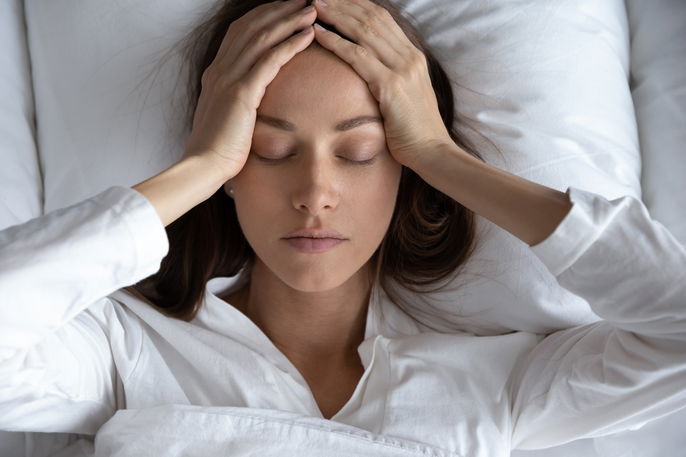Pain at the top of the head is not a very common finding, and is usually not related to any serious conditions. It is usually a result of excessive fatigue and muscle tension in the neck from inadequate posture.
When pain at the top of the head is accompanied by symptoms like nausea or bision changes, it may be a sign of more serious conditions, like hypertension or occipital neuralgia.
If your pain at the top of the head is frequent or accompanied b other symptoms, it is important for you to consult your doctor identify the underlying cause and start treatment as necessary.

Pain at the top of the head can be caused by:
1. Tension headaches
Tensional headaches usually occur due to contractions and stiffness in the neck muscles from excess stress, anxiety, depression or bad posture. These headaches are described as throbbing or pulsating at the forehead, but can also be felt at the top of the head.
Learn more about the symptoms of tension headaches and what can cause them.
What to do: To releive tension headaches, you should try to relax and massage the scalp to relieve pain. The doctor may recommend anti-inflammatories or analgesics to relieve discomfort.
2. Migraine
Migraines are very intense headaches that last 3 to 72 hours. This condition can be recurrent, and is very incomfortable. They are often triggered by certain factors, like excessive analgesic use, consuming caffeine or neurologic abnormalities.
Although migraines are usually associated with pain at the side of the head, pain can also be felt at the top of the head. pain can present with other symptoms like nausea, vomiting, vision changes and reduced sleep quality. Learn more about migraine symptoms and how to recognize this type of headache.
What to do: It is important to see a neurologist to recommend medication to relieve migraine-related pain. The doctor may prescribe anti-inflammatories, analgesics, triptans or anticonvulsants depending on the symptoms and pain characteristics.
3. Fatigue
Excessive fatigue can also lead to pain at the top of the head, especially after sleeping for less hours than normal. This can tire the body and the mind, and reduce mood, vision, productivity and concentration the following day.
See what can cause excessive fatigue and what you can do to prevent it.
What to do: In these cases, it is important to find ways to rest and relax. By recoverying your energy, the pain at the top of the head tends to improve. You can opt for massage, exercise, yoga, and most importantly, a good night's sleep. Try incorporating foods that give you more energy into your diet for an energy boost throughout the day.
4. Occipital neuralgia
Occipital neuralgia is characterized by inflammation of the nerves present in the occipital area. This can occur with a system disease, injury or tumor.
The condition causes intense headaches that are constant and worsen with neck movement, Although the pain is typically felt at the back of the head, it can radiate to the top of the head as well as to the sides.
What to do: Treatment for occipital neuralgia is prescribed by a neurologist depending on the presenting symptoms. The doctor may recommend head massages, rest, medications or surgery in very severe cases.
5. Hypertension
Hypertension is the term used to describe a high blood pressure. This condition usually does not cause any obvious symptoms, however a very sudden increase in blood pressure over 180/110 mmHg can lead to intense headaches felt at the back of the head which radiate to the top of the head.
In addition to headaches, other symptoms related to a sudden rises in blood pressure (otherwise referred to as a hypertensive crisis) blurry vision, changes to respiratory rate, dizziness and confusion. Read more about the symptoms of high blood pressure to be sure you can recognize a hypertensive crisis.
What to do: A hypertensive crisis is a medical emergency which requires immediate assessmet. If you notice symptoms, proceed to the hospital, as starting treatment promptly can prevent complications like internal bleeds and heart failure.
Treatment in the hospital may involve IV administration of antihypertensives. The doctor may recommend lifestyle changes, like reduced salt intake and regular exercise. You can also check out these home remedies for blood pressure to incorporate into your prescribed medical treatment.






























